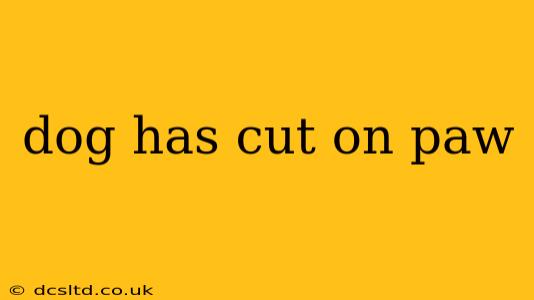Discovering a cut on your dog's paw can be alarming, but with calm, informed action, you can help your furry friend heal. This guide will walk you through assessing the injury, providing first aid, and knowing when to seek veterinary care. We'll cover everything from minor scrapes to more serious lacerations.
How Serious is My Dog's Paw Cut?
Assessing the severity of your dog's paw injury is the first crucial step. Consider these factors:
- Depth of the cut: A superficial scratch will likely heal on its own, while a deep cut may require stitches.
- Bleeding: Minor bleeding is normal, but profuse or continuous bleeding warrants immediate veterinary attention.
- Signs of infection: Increased swelling, redness, pus, or a foul odor are signs of infection and necessitate veterinary care.
- Location of the cut: Cuts between the toes or on the paw pads can be particularly problematic due to their sensitivity and potential for infection.
- Your dog's overall demeanor: Is your dog limping excessively? Is it showing signs of pain or distress? These are important indicators of the severity of the injury.
What to Do If My Dog Cuts Its Paw?
1. Assess the Situation: Carefully examine the paw. Note the depth, location, and amount of bleeding. Remain calm to keep your dog calm.
2. Clean the Wound: Gently clean the wound with lukewarm water and a clean cloth or gauze. Avoid using hydrogen peroxide or rubbing alcohol, as these can damage the tissue and delay healing. If there's debris in the wound, try to gently remove it with tweezers after cleaning.
3. Control Bleeding: Apply gentle pressure with a clean cloth to stop any bleeding. If bleeding is profuse or doesn't stop after 10 minutes, seek immediate veterinary care.
4. Bandage (If Necessary): For minor cuts, a bandage may be helpful to keep the wound clean and protect it from further injury. Use a clean, non-stick bandage. Ensure the bandage isn't too tight, restricting blood flow. Consider a pet-specific bandage or sock to prevent your dog from removing it.
When Should I Take My Dog to the Vet?
1. Deep Cuts Requiring Stitches: If the cut is deep, exposing muscle, tendon, or bone, veterinary attention is crucial.
2. Excessive Bleeding: If you cannot control the bleeding, or it's profuse, your dog needs immediate veterinary care.
3. Signs of Infection: Any signs of infection (swelling, redness, pus, foul odor) require veterinary treatment to prevent further complications.
4. Broken Bones or Joint Injuries: If you suspect a broken bone or joint injury, immediately seek veterinary help.
5. Your Dog is in Significant Pain or Distress: If your dog is showing signs of severe pain or discomfort, don't hesitate to contact your vet.
How Long Does It Take for a Dog's Paw Cut to Heal?
Healing time depends on the severity of the cut. Minor scratches may heal within a few days, while deeper wounds can take several weeks. Keep the wound clean and dry, and monitor it for any signs of infection. Follow your veterinarian's instructions carefully if they've treated the wound.
Can I Put Neosporin on My Dog's Paw Cut?
Many human medications are toxic to dogs, and Neosporin is one of them. Do not use Neosporin or any other human topical medication on your dog's paw cut without consulting your veterinarian. Your vet can recommend appropriate pet-safe wound care products.
How Can I Prevent My Dog From Licking Its Paw Cut?
Licking can introduce bacteria and delay healing. Use a protective Elizabethan collar (cone) to prevent your dog from licking or biting the wound. You can also consider using a pet-safe bitter-tasting spray to deter licking.
My Dog's Paw Wound is Infected – What Now?
An infected wound needs immediate veterinary attention. Your vet will likely prescribe antibiotics and possibly other treatments to combat the infection and promote healing. Do not attempt to treat a suspected infection at home.
By carefully assessing the injury, providing appropriate first aid, and knowing when to seek veterinary care, you can ensure your dog's paw cut heals properly and without complications. Remember, your veterinarian is your best resource for any questions or concerns regarding your dog's health.
